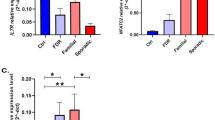Abstract
Multiple sclerosis (MS) is an inflammatory demyelinating disease of the central nervous system. Impaired remyelination and axonal degeneration may account for progressive disability in MS patients. As ciliary neurotrophic factor (CNTF) takes part in myelogenesis, we examined the frequency of a CNTF-null mutation in 349 MS patients with respect to their clinical presentation and in comparison with 434 healthy controls. Similar genotype frequencies for the CNTF mutation were obtained in MS patients (genotype 0101 = 74.8%, 0102 = 22.3%, 0202 = 2.9%) and controls (genotype 0101 = 71.7%, 0102 = 26.5%, 0202 = 1.8%) even after stratification for the HLA-DRB1*15 allele. In addition, there was no significant correlation of CNTF genotypes to age at onset, course or severity of the disease. We therefore conclude, that the requirement for CNTF in myelogenesis or cell survival may be bypassed by a second ligand or redundancy of functional activity of other neurotrophic factors.
This is a preview of subscription content, access via your institution
Access options
Subscribe to this journal
Receive 6 digital issues and online access to articles
$119.00 per year
only $19.83 per issue
Buy this article
- Purchase on Springer Link
- Instant access to full article PDF
Prices may be subject to local taxes which are calculated during checkout
Similar content being viewed by others
References
Martino G, Hartung HP . Immunopathogenesis of multiple sclerosis: the role of T cells Curr Opin Neurol 1999 12: 309–321
Trapp BD, Peterson J, Ransohoff BS, Rudick R, Mörk S, Bö L . Axonal transection in the lesions of multiple sclerosis N Engl J Med 1998 338: 278–285
Wolswijk G . Oligodendrocyte survival, loss and birth in lesions of chronic-stage multiple sclerosis Brain 2000 123: 105–115
Copelman CA, Cuzner ML, Groome N, Diemel LT . Temporal analysis of growth factor mRNA expression in myelinating rat brain aggregate cultures: increments in CNTF, FGF-2, IGF-1and PDGF-AA mRNA are induced by antibody-mediated demyelination Glia 2000 30: 342–351
Ip NY, Yancopoulos GD . The neurotrophins and CNTF: two families of collaborative neurotrophic factors Annu Rev Neurosci 1996 19: 491–515
Takahashi R, Yokoji H, Misawa H, Hayashi M, Hu J, Deguchi T . A null mutation in the human CNTF gene is not causally related to neurological disease Nat Genet 1994 7: 79–84
Giess R, Goetz R, Schrank B, Ochs G, Sendtner M, Toyka K . Potential implications of a ciliary neurotrophic factor gene mutation in a german population of patients with motor neuron disease Muscle Nerve 1998 21: 236–238
Barres BA, Schmid R, Sendtner M, Raff MC . Multiple extracellular signals are required for long-term oligodendrocyte survival Development 1993 118: 283–295
Louis JC, Magal E, Takayama S, Varon S . CNTF protection of oligodendrocytes against natural and tumor necrosis factor-induced death Science 1993 259: 689–692
Massaro AR . Are there indicators of remyelination in blood or CSF of multiple sclerosis patients? Mult Scler 1998 4: 228–231
Lam A, Fuller F, Miller J et al. Sequence and structural organization of the human gene encoding ciliary neurotrophic factor Gene 1991 102: 271–276
Epplen C, Jäckel S, Santos EJM et al. Genetic predisposition to multiple sclerosis as revealed by immunoprinting Ann Neurol 1997 41: 341–352
Lublin FD, Reingold SC . Defining the clinical course of multiple sclerosis: results of an international survey Neurology 1996 46: 907–911
Kesselring J . Multiple Sclerosis Cambridge University Press: Cambridge United Kingdom 1997 pp 116–120
Kesselring J . Multiple Sclerosis Cambridge University Press: Cambridge United Kingdom 1997 pp 121–124
Lelievre E, Plun-Favreau H, Chevalier S et al. Signaling pathways recruited by the cardiotrophin-like cytokine/cytokine-like factor-1 composite cytokine: specific requirement of the membrane-bound form of ciliary neurotrophic factor receptor alpha component J Biol Chem 2001 276: 22476–22484
Dell’Albani P, Kahn MA, Cole R et al. Oligodendroglial survival factors, PDGF-A and CNTF, activate similar JAK/STAT signaling pathways J Neurosci Res 1998 54: 191–205
Mertens C, Brassat D, Reboul J et al. A systematic study of oligodendrocyte growth factors as candidates for genetic susceptibility to MS Neurology 1998 51: 748–753
Acknowledgements
We would like to thank our patients for their cooperation and Anke Kalt for her valuable and expert technical assistance.
Author information
Authors and Affiliations
Corresponding author
Additional information
Institute of Human Genetics, Medical School Hannover, Carl-Neubergstr. 1 D-30625 Hannover, Germany
Rights and permissions
About this article
Cite this article
Hoffmann, V., Pöhlau, D., Przuntek, H. et al. A null mutation within the ciliary neurotrophic factor (CNTF)-gene: implications for susceptibility and disease severity in patients with multiple sclerosis. Genes Immun 3, 53–55 (2002). https://doi.org/10.1038/sj.gene.6363818
Received:
Revised:
Accepted:
Published:
Issue Date:
DOI: https://doi.org/10.1038/sj.gene.6363818
Keywords
This article is cited by
-
The neuropoietic cytokine family in development, plasticity, disease and injury
Nature Reviews Neuroscience (2007)
-
Is there a role for neurotrophins in the pathology of multiple sclerosis?
Journal of Neurology (2007)
-
Ciliary neurotrophic factor (CNTF) genotype and body composition
European Journal of Human Genetics (2004)



